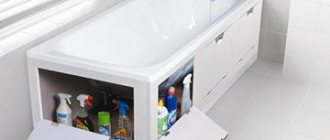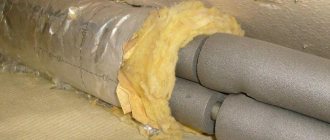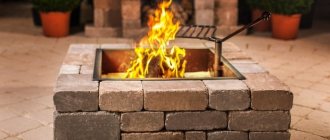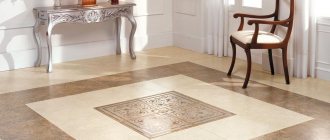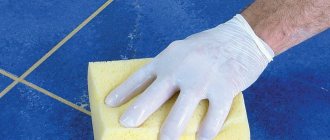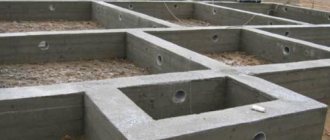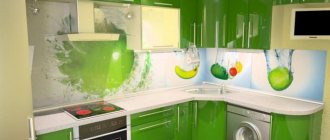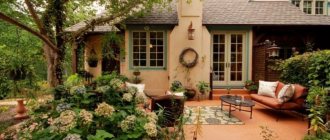The decorative panel under the bathtub gives the bathroom a finished look. To decorate it, you can choose a plastic or acrylic design. However, they will cost a lot, especially if the bowl has a non-standard shape.
It will be cheaper to build this screen yourself from tiles, which are glued onto a specially prepared frame. In addition to financial benefits, this decor option will fit perfectly into the interior of the room - they try to choose ceramic finishes in accordance with the walls and floor.
Let's figure out how to make a screen for a bathtub - we'll describe the methods of arranging the base for tiles and the technology of facing work. We have supplemented the information with visual photo instructions and videos that will help you carry out all the finishing processes yourself.
Solid screens for bathtubs
A simple and inexpensive decor option. The model is a frame made of monolithic material (brick, plastic, plasterboard, plexiglass), lined with tiles.
The permanent screen is durable and easy to maintain, but has a big drawback: to provide access to communications (in the event of a plumbing breakdown or water leak), it is necessary to dismantle the structure; the space under the bathtub is inaccessible for use.
A blind screen requires the presence of plastic pipes that are not subject to corrosion; before installing the element, make sure that the plumbing is in good working order.
With inspection window or door
The model is a stationary partition with a technological hole left during installation, providing access to check the operation of the sewage system. The window is left open or a door is hung (with a push, sliding or swing opening mechanism).
Sliding
Installation of this type of structure allows you to maintain full access to the pipes. The screen is a frame frame with sliding or hinged doors (with a roller or sliding opening mechanism), mounted on the floor or legs.
The hinged model looks harmonious with the bathroom cabinets, pencil cases and bedside tables, designed in the same style. The disadvantage of the design is the loss of space when opening doors, which is important for small rooms.
Opening the sliding screen does not require a large space; the design is easy to install and can be installed on bathtubs of any type and size. The frame for the partition is made of aluminum or plastic.
With footwell
When bathing a child, washing animals or washing clothes, it becomes necessary to get close to the bathtub, so when installing the screen, you can provide a niche for the feet, which is located in the center or along the entire length of the partition. For this purpose, the screen frame can be made with a slope.
Painting
Painting is a traditional way of decorating walls in wet rooms, almost forgotten for some time due to the impracticality and unattractiveness of the resulting coating. The paint was only oil, the walls were not very smooth (to put it mildly), and in general the appearance was poor. New technologies and materials make it possible to achieve a perfectly smooth surface, a variety of colors - different effects. All this at low cost. This is gradually reviving a forgotten option for finishing a bathroom - painting the walls.
Preparing the walls
A perfectly flat surface is required for painting and it can be made this way using moisture-resistant putty. It can be applied to plaster or drywall. Regardless of the base, with sufficient skill, the surface becomes truly ideal. Not a single flaw - it's possible.
The surface to be painted must be perfect
The prepared walls or ceiling are primed with a composition with an antibacterial and water-repellent component; after drying, you can begin to apply paint.
Types of Bathroom Paints
But not all paints can be used in the bathroom, since not all of them are moisture resistant. The following paints and varnishes are suitable:
- Water-based paints based on latex and acrylates. Acrylic water emulsion is an inexpensive option that can withstand high humidity, but it should not be used in close proximity to a bathtub, shower or washbasin. Latex emulsion forms a dense waterproof film on the surface and even slightly “tightens” unevenness, if any. See how to paint walls with water-based paint here.
- Alkyd paints. In appearance they are very similar to oil ones, but have better characteristics, they can be glossy, semi-glossy, matte. Among the advantages - it has average vapor permeability and low price. Disadvantages - emphasizes all the irregularities, changes color over time - acquires a yellowish tint. Another drawback is that they are made on the basis of organic solvents (white spirit, gasoline, turpentine), so the smell is strong before drying.
- Silicate paints. The main advantage is that fungus or mold will not appear on walls and ceilings painted with this paint. There are also advantages: very high vapor permeability, strong and durable coating. Disadvantage: until the composition has dried, it is very harmful to humans. As soon as crystallization has occurred, the coating becomes absolutely harmless, but you must work in protective clothing and a respirator and leave the house before it dries. Another unpleasant point: no other paints “stick” to silicate paints. If you want to change the type of paint, you will have to clean everything off.
- Based on silicones. This compound is 100% waterproof. It does not conduct water in any form - in the form of steam either. Therefore, when finishing with this type, you will have to do very powerful ventilation.
- Chlorinated rubber. Paints of this type are used in swimming pools to paint bowls, so they are even suitable for walls near the bathtub or shower stall. But you will also have to take care of good ventilation and removing the coating before the next painting.
As you can see, there are many options for finishing a bathroom with paint. Most can be used on a limited renovation budget, but chlorinated rubber and silicone are not very cheap.
Forming a base for tiles
Plasterboard sheets on a frame
The advantages of this material are strength, resistance to mechanical stress, ease of processing, flexibility (important when making custom-shaped screens) and relatively low cost.
Required tools and materials:
- mounting level;
- roulette;
- marker;
- screwdriver, hammer drill;
- guide and rack metal profiles or wooden beams;
- hammer;
- scissors for cutting metal;
- self-tapping screws, plastic dowels;
- primer, roller and brushes;
- drywall.
Stages of frame manufacturing:
- determine the outer boundary of the partition, keep in mind that there will also be facing material on top of the drywall. Along the walls adjacent to the side parts of the bathtub, mark the line for installing the beam or profile so that it is deepened from the edge of the bowl by the thickness of the cladding;
- connect the resulting vertical marks with a horizontal line on the base of the floor, controlling its evenness relative to the sides of the bowl with a plumb line;
- Drill holes along the perimeter of the line with a hammer drill in increments of 150-200 mm, hammer in the dowels;
- cut the guide profile or beam to appropriate sizes, secure with self-tapping screws; additionally glue it to the base of the floor with sealant;
- fasten the vertical rack profiles with a pitch of 600 mm. If a technological hole is left, install additional racks in this place; when installing a niche for the feet, install the floor profile in the shape of the letter U with a recess for the bathtub (the racks in the niche are installed at an angle);
- cut the drywall in accordance with the measurements, keep in mind that the material is attached at a distance of 1 cm from the floor and the edges of the bathtub bowl - this prevents the material from swelling;
- fix the drywall to the frame with self-tapping screws;
- Insulate the seams and joints with sealant and coat the material with a primer.
If using a wooden beam as a frame, coat the material with a special antiseptic. It is advisable to make the structure from moisture-resistant grades of plasterboard (green sheets).
Brickwork
A brick bath screen is considered a solid base and is most suitable for tiling, but the installation process requires significant labor.
Required tools:
- trowel (trowel for masonry);
- polyurethane foam;
- a mixture of cement and sand;
- container for mixing the solution;
- building level;
- hammer for chopping bricks;
- bricks.
Frame installation includes the following work:
- calculate the required amount of material, taking into account the size of the brick and the masonry technology (a quarter or half a brick);
- Use a level to mark the floor and walls of the bathroom. The laying is done so that the edge of the bathtub protrudes beyond the brick wall by 2 cm - the tiles laid on a layer of adhesive will be recessed under the side;
- lightly moisten the floor surface - this will improve the adhesion of the frame to the base;
- mix the solution in accordance with the brand of cement used;
- carry out masonry from one wall to another, with bricks offset in each subsequent row, taking into account the need to leave a technological hole or niche for feet;
- leave a gap of 2-3 cm between the side of the tank and the last row; after the solution has dried, fill it with foam;
- plaster the brick frame.
You can check the evenness of the masonry during installation using a rope stretched between the outer bricks of the row.
Partition made of tongue-and-groove slabs
Construction gypsum or silicate products are an alternative material, which is a hollow slab measuring 667x500x80 mm, with a support (with a groove) and a connecting (with a ridge) side. To make a bath screen, a moisture-resistant type of board is used.
Required tools:
- mounting level or plumb line;
- roulette;
- tile adhesive or gypsum plaster;
- acrylic primer;
- metal spatula;
- wood hacksaw;
- slabs
Carrying out work on making a screen for a bathtub:
- clean surfaces from dust and debris;
- Apply primer to the base;
- transfer the points of the outer boundary of the bathroom to the floor using a level or plumb line, draw a line along the resulting marks. If the tank is located in the center of the room, mark the perimeter;
- step back another 5 mm into the space under the bathtub from the markings and draw a new line - this is the outer border of the screen (if you follow the rule, the facing tiles will not protrude over the side of the bowl);
- prepare the adhesive solution for work;
- Apply the mixture using a spatula to the groove and ridge of the slab, install the product in the desired location, and join adjacent elements. The thickness of the seam at the joints should be no more than 2 mm; adjust the position of the blocks by pressing or lightly tapping;
- check the position of the masonry with a level;
- If you need to cut the material, make markings on the tiles and cut them using a hacksaw.
When fixing elements with tile adhesive, tongue-and-groove blocks do not need to be wetted with water; When using gypsum plaster, each element must be moistened before installation.
Floor and wall tiles: what to look for when buying
Bathroom finishing products are divided into two main categories:
- materials intended for flooring;
- materials for walls.
Beauty and practicality - all this combines the flooring in question
Selecting floor covering
When deciding on the finishing material for the floor, know that choosing tiles will be the most correct, since other products in this category do not have the necessary qualities for long-term service in conditions of high humidity
When purchasing a product, you need to take into account whether it has specific characteristics:
- moisture resistance is a prerequisite, since the likelihood of water getting on the product is very high;
- resistance to changes in moisture and temperature in the room;
- resistance to abrasion and chemicals, this is an important point, because from time to time the bathroom has to be cleaned using cleaning products;
- to avoid injuries, you should choose plates with an anti-slip surface for the floor;
- the product must have a uniform color, especially if you choose tiles with a pattern;
- no chips or scratches.
The tile has five wear resistance classes
The higher the class, the more expensive the cost and, accordingly, the greater the resistance to abrasion and damage of the plates. Manufacturers are required to indicate the degree of wear resistance on each batch of goods:
- Class I - the coating is used in places where people do not wear street shoes, only soft slippers and not intense traffic, can be used in bathrooms and bedrooms;
- Class II - tiles are installed in bathrooms and showers, bedrooms, but not in kitchens and hallways, where there is the highest traffic in the house;
- Class III is the best option for renovation work in residential premises, as the material can withstand average traffic density;
- Class IV - the product is used in public places where there is a fairly high concentration of people - shops, hotels, offices;
- Class V is the most wear-resistant surface and can be used in any public places, including railway stations and airports.
Products higher than third class should not be taken home
But for the home, it makes no sense to buy products above the third class, since there will not be a high load on it.
When choosing a tile, you need to pay attention to the raw materials from which it is made (we will talk about this below), as well as the size of the plates and their shape
You can create your own tile pattern at home
Let's start decorating the walls
The main purpose of wall tiles is, of course, moisture insulation, and then its decorative component. Therefore, when going to buy finishing materials, you also need to arm yourself with knowledge, based on which you will make the right choice:
the product must have high water-repellent properties, that is, water should not be absorbed, but remain droplets on the surface; You need to purchase tiles only from one batch of goods, otherwise you risk getting a color discrepancy; pay attention to the grade, there are three of them: if the coating of the first grade is the highest quality and durable, then the third - on the contrary (the grade also affects pricing); Just like flooring, high-quality wall coverings should not have chips or scratches.
Tiles can be used to decorate a room in any style.
The nuances of gluing tiles
- lamellas can be installed on a screen made of brick, tongue-and-groove elements, plasterboard or moisture-resistant plywood;
- install decorative cladding using a moisture-resistant solution or liquid nails;
- if using tile adhesive, spread the mixture on the back of the lamella with a notched trowel, apply liquid nails pointwise along the entire perimeter and in the center of the tile;
- start installing the first element from the top corner of the screen and be sure to control the position of the tiles using a building level;
- When laying tiles, insert dividing crosses into the spaces between the tiles;
- be sure to grout the joints with a moisture-resistant mixture - this will prevent moisture from penetrating under the tiles, mold development and damage to the integrity of the facing coating.
Make the screen from a material identical in its characteristics and colors to the lamellas on the walls.
Identification of difficult areas and preliminary preparation of walls
The concept of beauty lies not only in the external background of the main material, but also in the correctness of its structure. Beautiful bathroom tiling is based on:
- even trimming and laying out corners;
- on the correct design of the locations of pipes and plumbing units.
- on giving an attractive appearance to the installation points of sanitary equipment (baths, sinks)
To attach the tiles, you need to choose high-quality tile adhesive. Most often, these are universal types suitable for installing tiles on walls and floors. For example, "Unis Plus".
The walls are pre-prepared for finishing. The preparation process consists of dismantling the old coating and leveling the surfaces.
Considering that finishing a bathroom with tiles with your own hands is the only way for many people to carry out renovations, sometimes it is the preparation that becomes the most difficult stage for them.
Sometimes you have to knock down the top layer down to the base (concrete).
Naturally, all equipment is dismantled and removed from the premises. Space is needed for work
This is especially important for small baths.
Construction of a removable screen
You can make a removable bathtub panel from moisture-resistant oriented strand board.
Required materials and tools:
- hand or circular saw, jigsaw;
- wooden beam;
- furniture legs (with height adjustment);
- metal corners, screws;
- primer;
- moisture-resistant glue;
- notched and rubber spatula;
- grout mixture;
- facing lamellas;
- OSB.
Screen manufacturing includes the following work:
- take measurements of the bathtub;
- transfer the markings to the slab (make the height of the screen 4-5 cm less than the obtained value, so that there is a gap and your feet can enter);
- cut the sheet to size;
- cut the timber, attach a frame from it around the perimeter of the OSB;
- fix the legs at the bottom of the screen;
- treat the product with a primer, wait until it dries;
- glue the tile to the screen;
- fill the seams with moisture-resistant grout;
- Place the product under the side of the bath and adjust the height of the legs so that the screen is level and motionless.
After completing the work, check the structure for strength; if instability of the structure is detected, make additional stiffeners.
Decorative finishing methods
Many people want to implement non-standard solutions in arranging the bathroom interior. Therefore, they choose materials and technologies that are unusual for us. The positive effect of such actions can be seen in the photo of the bathroom decoration, and the decoration options themselves are as follows:
Linoleum for walls. Initially, such material was produced for medical institutions. And therefore it is moisture resistant, it can be washed even with aggressive compounds. For installation, a special soldering iron with a glue-type cord is used. There is no color variety yet, but you can choose calm shades or make the surface matte.
PVC panels without joints in the form of 2-3 mm plastic sheets with printed patterns. Pre-cut canvases are attached with glue.
Use of natural and artificial stone. For example, you can fix tiles of non-hygroscopic granite flagstone on the walls and then coat them with a protective varnish.
Wood is an expensive and not the best option, although it creates a unique and original look. Wood reacts poorly to moisture and quickly deteriorates. Therefore, careful impregnation with special compounds is required.
Tempered glass tiles are a durable and hygienic material that can visually expand the area. It has different textures and colors. Can be used in combination with other materials. But at the same time it is characterized by high cost.
There are many ways to decorate a bathroom. They can be traditional and unusual, strict and extravagant, expensive and budget. Each customer must independently choose the most suitable option for themselves. And then the interior will delight you for many years.
Bathtub cladding of complex shapes
If the tank bowl has a non-standard curved shape, a metal profile is suitable for making the frame; Use a sheet of plasterboard or extruded polystyrene foam as the sheathing material:
- measure the bathtub and cut the required amount of profile;
- make small cuts along the entire length of the guide rail in increments of 30 mm;
- attach the profile to the side and secure with tape. Lay the frame along the entire length of the bowl, making smooth bends at the cut points. To maintain the resulting shape, secure the strip with tape in several places as you work;
- clean the floor from dust and debris, transfer the border points of the sides to the base using a plumb line, draw a preliminary line;
- make an indent deep into the bathtub to the thickness of the facing tiles, adhesive mortar and plaster, mark the outer border of the screen;
- attach the profile to the floor using dowel nails;
- in accordance with the height of the bathtub, cut two metal slats and fix them on the walls;
- cut a sheet of plasterboard or polystyrene foam onto a panel 15-20 cm wide, depending on the amount of curvature of the bowl;
- insert the lower edge of each part of the screen into the profile, place the upper edge under the side of the bathtub and fill the space with construction foam;
- install the remaining panels in the same way, leaving space for an inspection window if necessary;
- insulate seams and joints with silicone sealant;
- Apply waterproof putty to the entire surface of the screen, after it has dried, sand the surface with sandpaper and begin tiling.
If the contour of the bath is too curved, the screen is covered with mosaic tiles (glass, ceramic, polymer materials), which are presented by manufacturers both as individual chips and in the form of modules on a paper or mesh basis.
Selection of plumbing fixtures and furniture
Plumbing equipment must be durable, reliable and multifunctional. It is better to buy products that were made from environmentally friendly materials. The color of the plumbing fixtures should be in harmony with the decoration of the room. Usually choose a bathtub, sink and toilet in classic white. They will not have to be changed if, even after a couple of years, the owner decides to change the color of the walls in the bathroom. All plumbing equipment should be selected at the same time. In this case, it will be possible to select the most suitable products for each other. Before purchasing devices, you should decide on the type of mounting and placement. Plumbing equipment comes in different sizes, and for small bathrooms you need to buy a sink and toilet in a slightly different format than for spacious bathrooms. General features of some types of plumbing fixtures are presented in the photo below.
| Plumbing equipment | Peculiarities |
| Shower cabin | Installed in small bathrooms. Modern shower cabins have a lot of additional functions: built-in radio, color lighting, massagers, etc. |
| Baths | Classic plumbing equipment. Bathtubs come in steel, cast iron, acrylic and even stone. Their appearance is determined by the general style of the room. |
| Toilets | It must be durable, reliable and as silent as possible (meaning the noise level when filling the tank with water). |
| Sinks | Can be of different sizes and shapes. They are mandatory plumbing equipment. |
Possible decoration options
- when installing the screen, add a pull-out shelf with magnets - the device will be useful for storing various household items;
- decorate the partition with a mirror cloth or mirror slats, which will visually expand the space of the room;
- An original, beautiful, durable and moisture-resistant material for making a screen is plexiglass (plain, colored, matte and glossy, smooth and with a relief surface;
- Choose small and medium-sized ceramic tiles for cladding - this will avoid a large number of cut elements.
If the appearance of the bathroom interior seems too restrained and monotonous, choose one of the many design options and design a bath screen that will match the size and features of the installed plumbing equipment.
Preparing the floor
The quality of the final floor covering directly depends on the preparation of the subfloor. The optimal solution in terms of price and quality would be to level the floor with a cement mixture. It is strictly not recommended to leave a wooden base, as in some old houses. Wood is a material subject to a high degree of deformation when exposed to moisture. On such a surface, the ceramic coating will adhere very poorly. In addition, this will significantly reduce the service life of the tiles.
Experts do not recommend laying tiles on boards or plywood
Examples in the interior
Beautiful examples
The modern use of tiles in the bathroom is akin to art. The finishing material is suitable for use in apartments and private houses. Examples of photo galleries will help you evaluate the possibilities of using tiles in the bathroom.
An example of accenting a wash area with modular tiles. Good choice of texture and color, matching the overall style concept.
An original choice of flooring for the Provence style. The texture, pattern and color fit perfectly into the design of a bathroom combined with a toilet.
An extraordinary solution for decorating a bathroom in an oriental style. Combining different textures, using dark tones.
Highlighting a niche with tiles with a three-dimensional ornamental pattern. A stylish way to decorate the wash area, a successful combination of shades.
Isolating a wet area around the bathtub fits into the Japanese style. Using wood texture.
A loft-style bathroom attracts with its combination of rough textures. A spectacular interpretation of an industrial facility. A combination of concrete and brick tiles.
Neutral version of high-tech style. The use of tiles does not create a fragmented effect. Selecting a bath area.
Chalet style bathroom. The abundance of tiles is smoothed out by the design of the ceiling.
Decorating a shower stall with tiles and accents. A combination of two textures and playing with a niche.
How to use bath and floor tiles. The cladding looks impressive against the background of wall slats in the form of panels.
A bright solution with a patchwork interpretation. Using mosaics to accent niches and walls near the toilet and sink.
Another solution in the loft spirit. Matte type of tile texture in combination with a concrete surface. The atmosphere of the industrial facility is fully conveyed.
Finishing the bathroom ceiling with relief tiles with a metallic sheen. Ceiling tiles combined with floor and wall tiles. Bathroom zoning.
You will learn how to lay tiles in the bathroom from the following video.
Doing the work yourself
The wall in the bathroom is cleaned of old decorative materials, leveled with plaster and primed. Markings are applied to the prepared surface. To make the marking lines even, use a plumb line or a long level. Next, you should prepare the adhesive mixture, following the instructions on the package, and begin applying it to the wall. At one time, the glue is applied to an area of 1 m² or so.
Don’t be lazy to check the correctness of the sticker along the plane, as well as horizontally and vertically. The displacement, invisible to the eye, will increase and entail serious reworking of the work. So it’s easier to correct finishing defects right away. On the Internet you can find many videos and photos that detail all the stages of tiling bathrooms.
The final stage will be grouting the joints. For this, special compounds are used that do not allow moisture and dust to get under the main finishing material. For work, you can use a cement or epoxy grout option. In addition, you can buy ready-made material or dry mixture.
https://youtube.com/watch?v=W_vSXutu71A
Style decision
The most common style that is most often used when decorating modern bathrooms is classic. This style involves the use of the so-called “dark bottom - white top” technique, when darker shades are chosen for cladding the lower part and floor than for the upper part of the walls and ceiling. At the same time, the black and white solution looks more organic in bathrooms with a large square footage than in small bathrooms.
Classic combination of dark and light tiles
A design solution in a classic style also involves using tiles of other sizes and colors for decoration and combining them. In general, classic design always looks cozy, stylish and harmonious; there are no flashy elements or elements that fall out of the overall design solution - everything from the shade of the tiles to the light in the room is thought out to the smallest detail and is in harmony with each other, creating a complete picture.
Designing a bathroom in an antique style will cost a little more in terms of costs for purchasing materials. Typically, design in this direction is used when creating the interior of spacious rooms. The most commonly used technique is alternating wide format tiles in beige colors with light splashes.
Antique style bathroom
The bathroom can be decorated in Greek or ethnic style. In the first case, warm beige and sand tones are traditionally combined, and in the second, designers resort to decorating the cladding in the style of cultures of other nations.
